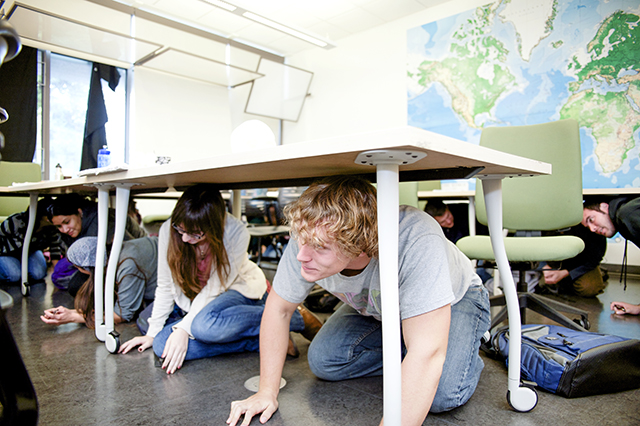
The annual preparedness drill reminds all California residents to practice the drop, cover and hold-on maneuver: sinking to the floor or ground, covering the head and neck with both arms and taking cover under a heavy table or desk.
If cover is non-existent, dropping to the ground in place and staying in one spot or moving next to an interior wall offers some protection.
To date, nearly nine million Californians have volunteered to participate in the Oct. 17 drill and registration remains open at shakeout.org.
The annual exercise is designed to instill a culture of earthquake and tsunami awareness and readiness. Quake experience demonstrates that practicing drop, cover and hold-on minimizes casualties and property damage while also hastening post-disaster recovery.
Recalling Loma Prieta as well as the more recent earthquake and tsunami in Japan, HSU Geology Professor Lori Dengler says, “What each of us does in our homes, schools, and offices, and what we do together as communities and as a state, will determine whether California’s next major earthquake will be a natural disaster from which we recover quickly or a major catastrophe that affects our way of life for many years.”
State and county officials urge residents to secure the contents of their homes and offices, organize emergency supplies and update family emergency plans in preparation for the ShakeOut.
“The most dangerous place to be during an earthquake is the interface between indoors and outdoors,” warns Dengler, who has been part of post-event reconnaissance teams at major earthquake sites around the world. “Doorways are no stronger than the rest of modern buildings and people can be injured by swinging doors or people rushing to escape outside. Participation in the ShakeOut drill is important for people to develop the muscle memory to do the right thing when the next earthquake strikes.”
Details of what to do are at dropcoverholdon.org. Regional information for Northern California is posted at humboldt.edu/shakyground.
A 32-page, full-color guide contains the latest information about regional earthquake and tsunami hazards. Titled “Living on Shaky Ground,” the booklet presents a seven-step plan of action for readiness and mitigation before, during and after earthquakes.
One of the most important elements of the ShakeOut drill and the booklet is the opportunity that both provide for discussion and systematic planning, according to Dengler. “Sociological research shows that before people act, they need to talk things through, a process that sociologists call ‘milling.’ People are more likely to store food and water, secure their bookshelves and write up a family preparedness plan if they’ve discussed it among themselves first. When you’re ready ahead of time, you greatly increase your chances of saving yourself and your family, reducing your losses and helping your community recover faster.”
Reliance on government and emergency services is not enough, Dengler cautions. “The government is there to assist afterwards, but the definition of a disaster is that normal emergency services are completely overwhelmed. The only way you’re going to get help is to be prepared yourself. This is a personal, a neighborhood and a community responsibility.”
The Humboldt Earthquake Education Center, an adjunct of Humboldt State, distributes educational materials such as “Living on Shaky Ground” to schools, the press and the public.
The center operates the Humboldt Earthquake Hotline (707-826-6020), a recorded message updated daily about local, regional and worldwide activity. The center also conducts intensity studies of regional earthquakes.
The Humboldt Earthquake Education Center is at humboldt.edu/shakyground and also can be reached at (707) 826-6019.